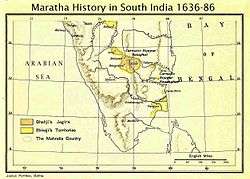Dodda Kempadevaraja

Dodda Deva Raja (also Dodda Kenpa Deva Raja) was the wodeyar ruler of Mysore (a principality or petty kingdom in southern India) from 1659 until 1673.[1]
| Mysore Kings (1399–present) | |
| Feudatory Monarchy (As vassals of Vijayanagara Empire) (1399–1553) | |
| Yaduraya Wodeyar | (1399–1423) |
| Chamaraja Wodeyar I | (1423–1459) |
| Timmaraja Wodeyar I | (1459–1478) |
| Chamaraja Wodeyar II | (1478–1513) |
| Chamaraja Wodeyar III | (1513–1553) |
| Absolute Monarchy (Independent Wodeyar Kings) (1553–1761) | |
| Timmaraja Wodeyar II | (1553–1572) |
| Chamaraja Wodeyar IV | (1572–1576) |
| Chamaraja Wodeyar V | (1576–1578) |
| Raja Wodeyar I | (1578–1617) |
| Chamaraja Wodeyar VI | (1617–1637) |
| Raja Wodeyar II | (1637–1638) |
| Narasaraja Wodeyar I | (1638–1659) |
| Dodda Devaraja Wodeyar | (1659–1673) |
| Chikka Devaraja Wodeyar | (1673–1704) |
| Narasaraja Wodeyar II | (1704–1714) |
| Krishnaraja Wodeyar I | (1714–1732) |
| Chamaraja Wodeyar VII | (1732–1734) |
| Krishnaraja Wodeyar II | (1734–1761) |
| Puppetry Monarchy (Under Haider Ali and Tipu Sultan) (1761–1799) | |
| Krishnaraja Wodeyar II | (1761–1766) |
| Nanjaraja Wodeyar | (1766–1770) |
| Chamaraja Wodeyar VIII | (1770–1776) |
| Chamaraja Wodeyar IX | (1776–1796) |
| Puppetry Monarchy (Under British Rule) (1799–1831) | |
| Krishnaraja Wodeyar III | (1799–1831) |
| Titular Monarchy (Monarchy abolished) (1831–1881) | |
| Krishnaraja Wodeyar III | (1831–1868) |
| Chamaraja Wodeyar X | (1868–1881) |
| Absolute Monarchy Monarchy restored (As allies of the British Crown) (1881–1947) | |
| Chamaraja Wodeyar X | (1881–1894) |
| Krishnaraja Wodeyar IV | (1894–1940) |
| Jayachamaraja Wodeyar | (1940–1947) |
| Constitutional Monarchy (In Dominion of India) (1947–1950) | |
| Jayachamaraja Wodeyar | (1947–1950) |
| Titular Monarchy (Monarchy abolished) (1950–present) | |
| Jayachamaraja Wodeyar | (1950–1974) |
| Srikanta Wodeyar | (1974–2013) |
| Yaduveera Chamaraja Wadiyar | (2015–present) |
Early years
Dodda Deva Raja was born on 25 May 1627, the fourth son of Prince Devarajendra Wodeyar, by his second wife, Kempamamba Ammani Avaru. He was imprisoned with his father at Hengul Fort in 1638, the year of incumbency of his cousin Kanthirava Narasaraja I. He was adopted and appointed heir apparent, with title Yuvaraja on 28 July 1659. He succeeded his cousin on the latter's death on 31 July 1659, and was installed on the Mysore gaddi on 19 August 1659
Rule
During his rule, the last of the Vijayanagara rulers sought refuge in Bednur.[1] Soon afterwards, Sivappa Naik, the Nayaka of Kelladi attacked Seringapatam with a large force and with the ostensible intention of restoring Vijayanagara rule at Srirangapattinam.[1] However, the Mysore forces, led by Dodda Kempadevaraja, repulsed the attack and thereafter pursued the attackers into the malnad region to the west, where they captured more territory.[1] Dodda Kempadevaraja also abrogated his nominal allegiance to Vijayanagar and declared his kingdom to be independent.[1] Soon the Naiks of Madura invaded Mysore as well; they too were repulsed and chased back into their own dominions, where Erode and Dharapuram were annexed to Mysore and Trichonopoly was forced to pay tribute to Mysore.[1] When His Highness Dodda Kempadevaraja died in Chiknayakanhalli, the northernmost outpost of his territories, in 1673, his dominions had considerably expanded.[1] They extended now to Dharapuram in Coimbatore in the south, Sakrepatna to the west, and Salem to the east.[1] Dodda Deva Raja died on 11 February 1673.
See also
Notes
References
- Imperial Gazetteer of India: Provincial Series (1908), Mysore and Coorg, Calcutta: Superintendent of Government Printing. Pp. xvii, 365, 1 map.